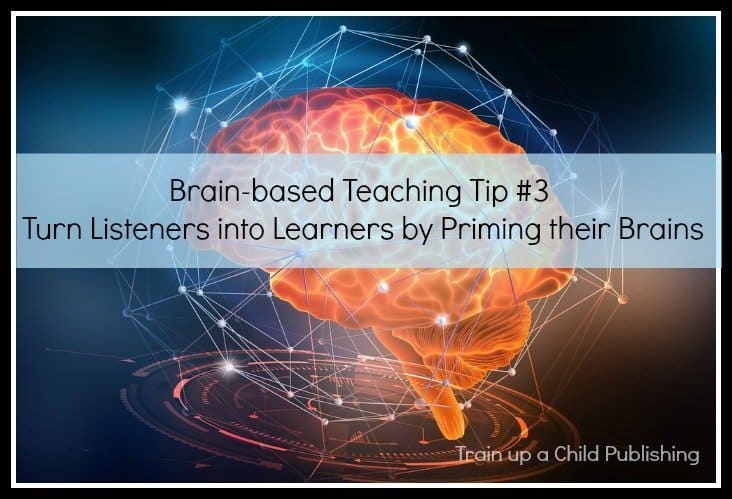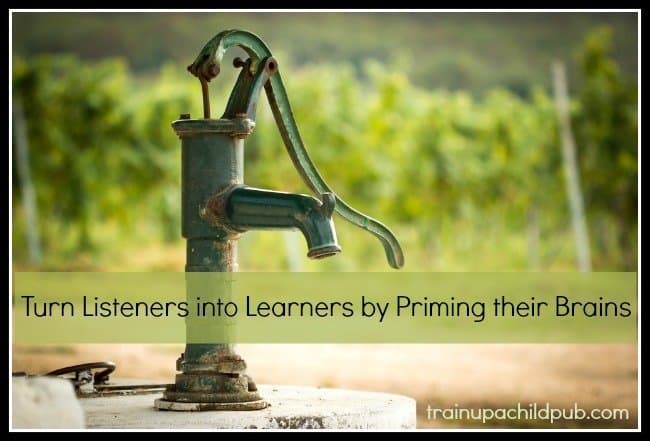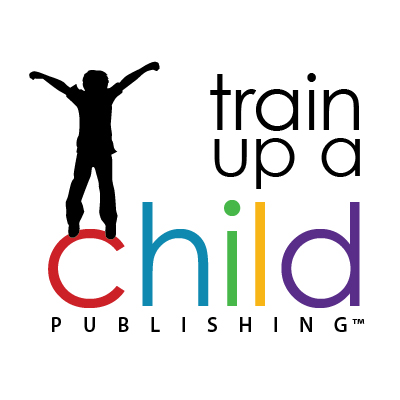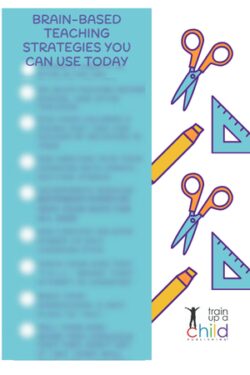Turn Listeners into Learners by Priming their Brains

Remember reading about how people prior to running water had to “prime the pump”? They pushed and pulled the farmyard water pump handle up and down to build up the pressure until the water started coming up out of the well. Or maybe you’ve done the same thing with your lawnmower or gas grill by pushing a button to “prime” it, or get it ready to turn on. Anyway, just as we prime the pump to get water to come out, we turn listeners into learners by priming their brains. By priming their brains, we get kids focused and ready to learn.

So according to recent brain-based teaching and learning research, scientists say you can get your kids’ brains ready to absorb information by priming them. You can do this with your children by simply reviewing what you have learned in the past and connecting it to what you are going to be learning next. I’ll tell you more about how to do that in a minute.
- This simple, two-minute habit of priming your kids' brains can turn lazy listeners into learners!
- A KWL chart in action
- Here's what it may look like in science:
- Or in grammar/language arts:
- So I want you to take advantage of all of these brain-based tips to make it easier to make your kids learning stick. Try Priming and see what a difference it makes in turning your listeners into learners!
- Want to read the rest in the Brain-based Teaching series? Here you go:
This simple, two-minute habit of priming your kids’ brains can turn lazy listeners into learners!
Carnegie Mellon researchers have confirmed that we learn better when we can attach something new to something we already know. If your student is familiar with the structure of castles in the middle ages, for example, it’s not much of a jump for her to learn about siege warfare.
Charlotte Mason’s Intellectual Habit of Reflection
If your homeschooling follows the Charlotte Mason philosophy, you may think this idea of “priming our kids’ brains” sounds familiar. Charlotte Mason’s talked about the intellectual habit of reflection. Just as you might think, this is ruminating over what one has heard or learned (Charlotte Mason’s Home Education Series, Vol. 3, School Education, Chapter 11.)
This is almost the same principle! One of the best ways to practice reflection is to get your students in the habit of narration. See how to teach narration here. The difference here is just that reflection or narration generally takes place after the lesson — but with priming, it takes place before the next lesson.
So here are two scenarios when you might consider using this priming strategy to get your kids ready to learn:
- to get them ready to learn something new
- to cement past learning prior to continuing a lesson
Let’s expand those.
Help your children automatically focus, learn, and remember more by grabbing our brain-based teaching tips checklist by clicking on the graphic below to download.
Priming kids’ brains and turning listeners into learners at the beginning of a new unit of study
One way is to get your kids’ brains ready for new learning is to start by reviewing what your children already know about a subject before you start adding new information. One way we did this in our homeschool when we were starting a new topic is to use a modification of the “KWL” approach.
Typically, a “KWL” chart is a chart with three columns. In the first column, you list what you already Know (or think you know) about something. Use the second column to list what you Would like to know or what you Wonder about the topic. In the third column, usually after reading a book, article, etc., your student would fill out what she Learned about the topic.
(Alternatively, some like to use these prompts: What you think you Know, What questions do you have or what are what are you Puzzled about, and what you can Explore about a topic.)
A KWL chart in action
Sometimes when approaching a new unit or brand-new topic, we would brainstorm a list of what we already knew about it (“we” meaning “my kids”) first.
Then we’d make a second list of the things we would like to know or were curious about the topic. You can make lists like this on large white paper to hang on the wall, a whiteboard, or a computer document.
This is a helpful “brain warm-up” activity that gets your kids thinking and ready to learn. So let’s say you were about to study the French Revolution. Your first list would be:
- K (What do you know about the French Revolution?)
And your kids would list or say what they knew, and you might write it down. (Unless you have a budding teacher who likes to be the one to write.)
Secondly, you would make a list of questions under the second heading:
- W (What would you like to know or what do you wonder about the French Revolution?)
For this second list or column, your students may have a few questions. But here is another chance for you to practice priming their brains by helping them come up with additional questions.
In fact, you can stimulate your children’s imaginations by ‘thinking aloud.’ Let’s say someone piped up with a fact about the peasants storming the Bastille (prison) in Paris. You might say something like… I wonder how the people reacted to seeing or hearing about that kind of violence. And then help your student(s) formulate questions like these:
- How did different people react to this event … how did the peasants react? The aristocracy? The prison guards?
- What happened to all the prisoners?
- What happened after this event took place?
A fun way to extend this idea is to take the questions, write them down and add them to a “Question Box” (along with some other questions of your own making). Use the Question Box strategy daily before beginning your history study or reading. This is perfect for multi-age siblings that are studying the same topics at the same time. Just make sure you write questions appropriate for the different ages you have studying together.
You can also have your students write down each question that’s answered correctly along with the answer and keep that in the history section of their notebook. Use some of the sentences for memory work for that week.
Does this post inspire you? Click on the graphic below to grab our brain-based teaching tips checklist to help your kids focus, learn, and remember more.
Priming kids’ brains in an ongoing study
This priming strategy can also be used on a daily basis to connect the history, grammar, or fine arts lesson to the one you had the day or week before. Asking students questions like the examples below helps warm up those brains and get them primed to learn new information:
When you are about to start a daily read-aloud (continuing the example using the French Revolution) ask:
- When we read our book yesterday, what was going on?
- What happened to (a major character or two) in the book?
- How was the French Revolution progressing in that chapter?
- What do you think might happen next?
Please don’t feel as though you need to ask all of those questions. You might just ask the first one and if you get a fairly complete answer, that’s all you need to ask.
If you have more than one student, ask for input from the others and by the time they’ve answered you’ll have built up the momentum to begin that day’s reading or discussion.
Priming kids brains and turning listeners into learners during a lesson
Priming the brain can (and should) also happen during a lesson. Corporate trainer Sharon Bowman teaches the “ten-minute rule.” She asserts that after every ten minutes of lecture you should stop and spend a minute or two getting some feedback about what has just been learned.
By reflecting on what they just heard, your listeners are priming their brains for further learning.
This is a great teaching tool anytime you teach with lectures. You can do this by asking for your student to narrate what she just heard. Or you can ask a student to write what she’s just heard (a written narration). You can also have an informal conversation about it.
Occasionally stopping to get some feedback also helps your students focus and pay attention better. And it’s helpful for you to know how much they are getting out of your lectures. If you find lecturing isn’t working as well as you thought, you could change things up a bit. See tip #2 and the rest of the posts in our Brain-based Teaching Tips series for some ideas!
Grab our Brain-based Teaching Tips Checklist by clicking on the graphic below.
Can I use this when studying subjects other than history?
Yes. It’s the same thing — just apply what you read above to different topics. You are basically just reviewing:
- What your student(s) already knows about a topic
- What your student(s) recently learned about a topic
When you ask a question or two before you begin, you’re getting your students into “learning mode.” You’re priming their brains and getting them ready to focus and learn.
Here’s what it may look like in science:
- Can you tell me about (or draw) the part of the lifecycle of the butterfly that we read about yesterday? Do you know what comes next?
- We read about igneous rock on Tuesday. Describe how igneous rock is formed before we continue reading.
- Do you remember some characteristics of amphibians from what we talked about (or observed from our nature walk) yesterday?
Or in grammar/language arts:
- Before we begin today’s lesson, let’s review what you learned yesterday. Tell me how you punctuate a sentence when it has a series of three things in it. Example: How would you punctuate this sentence? Heather went to the store and bought eggs lettuce and bread
- What did we learn on Wednesday about how to write a proper pronoun that’s different than a regular pronoun?
- From our discussion yesterday, describe the different points of view that the narrator can use to write a novel.
- Thinking about the story we’ve been reading aloud, describe the setting. How does the setting of this story make you feel? Why do you think the author chose this setting?
However you do it, priming your children’s brains to learn only takes a tiny bit of forethought and a few extra minutes, but it yields great results.
I believe you can bring your kids’ homeschooling to life while balancing your other responsibilities.
So I want you to take advantage of all of these brain-based tips to make it easier to make your kids learning stick. Try Priming and see what a difference it makes in turning your listeners into learners!
Happy learning!

Want to read the rest in the Brain-based Teaching series? Here you go:
Brain-based Teaching Tips for your Homeschool
Teach your children to believe in themselves. (Not technically part of the series, but closely related)
#3 Brain-based Teaching Tip #3: Turn Listeners into Learners by Priming Their Brain



I love this, Dana! This is applicable on so many levels and can be used throughout the day in so many ways! Thank you for this encouragement.
Hi Kathryn! I’m glad it spoke to you and was encouraging! I think you’re right about this information being useful throughout the day with our children — so simple but so beneficial. Thanks for taking the time to tell me your thoughts. 🙂